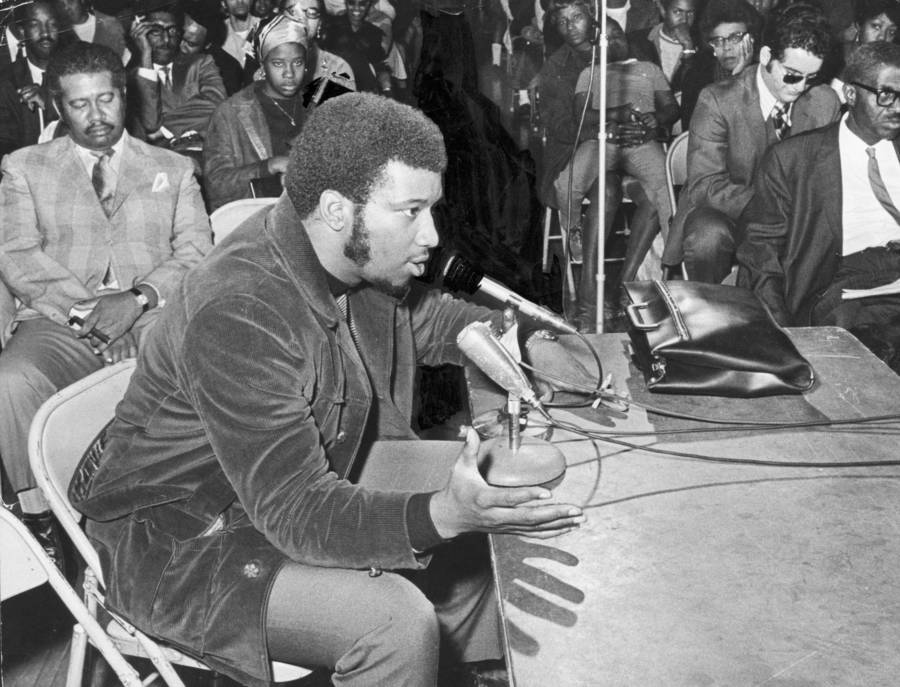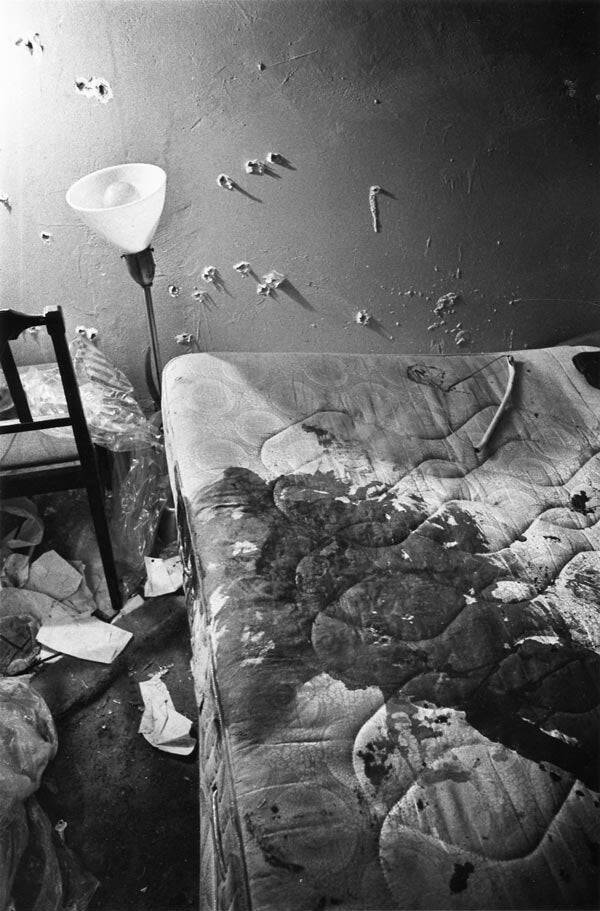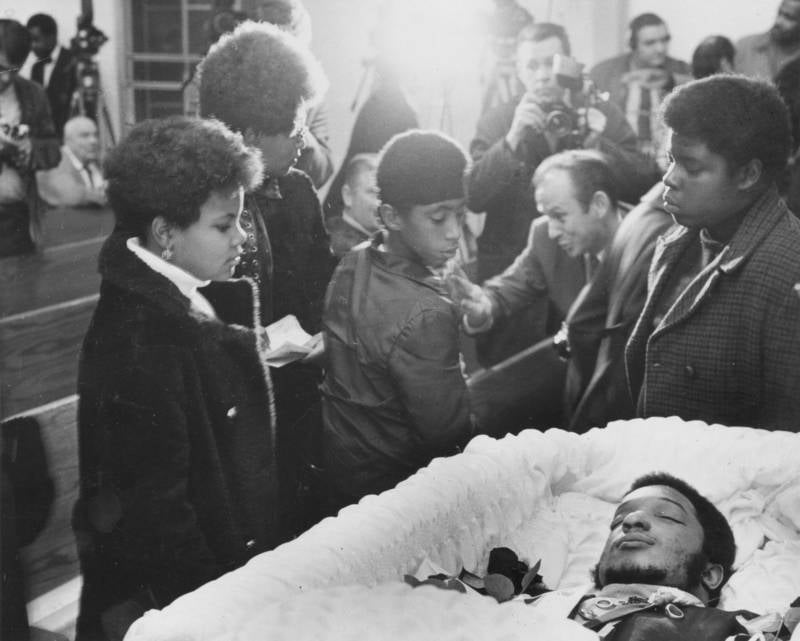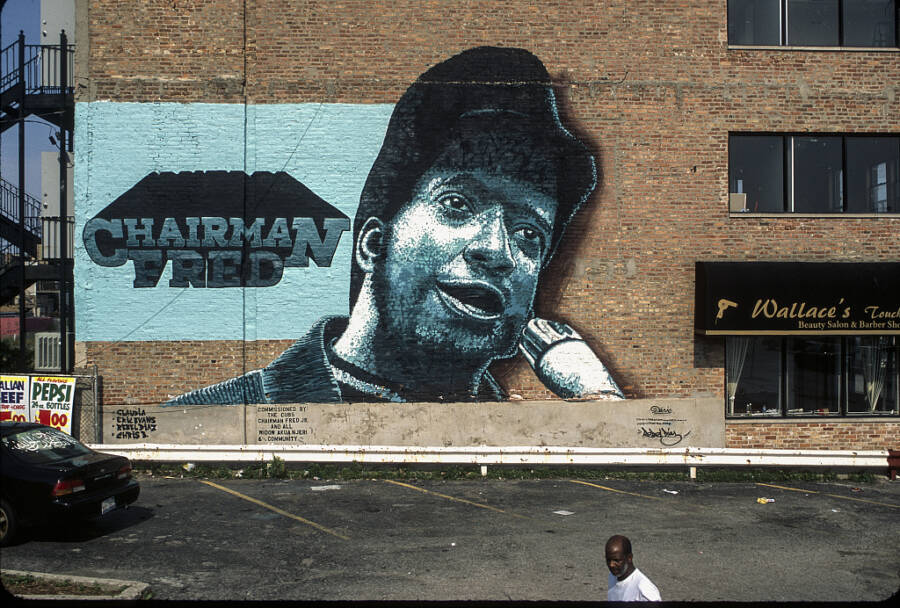While the Black Panthers called Fred Hampton's death a murder and the evidence proved them right, Chicago police insisted he was killed after firing on them during a shootout.
On December 4, 1969, a sudden crack of bullets shattered the early morning calm on Chicago’s West Side. The violent confrontation at 2337 W. Monroe St. would end in Black Panther Fred Hampton’s death — and prompt a battle between police and the Panthers over who was to blame.
Illinois State’s Attorney Edward V. Hanrahan called the incident “a gun battle.” But evidence quickly mounted that “the battle” had been blatantly one-sided.
The police had fired between 82 and 99 shots over the course of at least seven minutes. The Panthers inside, it seemed, had shot only once.

Don Casper/Chicago Tribune/TNS via Getty ImagesFred Hampton’s death at the age of 21 ended a promising career as an activist for Black rights.
But the early obfuscation of the Chicago Police was only the tip of the iceberg. Fred Hampton’s death was much, much more than a sloppy raid. In fact, it was murder made possible by a long-brewing conspiracy.
How Fred Hampton Got Involved In Civil Rights And The Black Panthers
Fredrick Allen Hampton was born on August 30, 1948, in the suburbs of Chicago. Both his parents had moved north as part of the “Great Migration,” the exodus of Black Americans from the South to northern industrial cities.
Hampton’s interest in advocating for equal rights started young. As a teenager, Hampton fought for basic rights like letting Black girls compete for homecoming queen or integrating his town’s swimming pool.
His activism attracted the attention of the local chapter of the NAACP. With their backing, Hampton helped boost the membership of their youth chapter from seven to 700.
But as the Civil Rights Movement developed, so did Hampton’s views. He grew disenchanted with the idea of non-violent protest as preached by Dr. Martin Luther King, Jr. Hampton found himself drawn instead to Malcolm X’s philosophy of self-defense.
“I am for violence if non-violence means we continue postponing a solution to the American Black man’s problem just to avoid violence,” Malcolm X famously noted in his 1965 autobiography. To Hampton, who had seen white people spit and throw rocks on Civil Rights marchers, this made sense.
His new philosophy toward Civil Rights dovetailed with a movement growing out of California: The Black Panthers. Founded in October 1966 by Huey P. Newton and Bobby Seale, the organization emphasized Black nationalism, socialism, and armed self-defense. In 1968, they opened a Chicago chapter and Hampton became involved.

Chicago Tribune file photo/TNS via Getty ImagesFred Hampton joined the Black Panthers’ Chicago chapter in 1968.
With Bobby Rush as the deputy minister and Hampton as the chairman, the Chicago Black Panthers set out to fight “racism, capitalism, and police brutality.” They also ran a preschool breakfast program and planned to open a medical clinic. And, following the teachings of Malcolm X — by the end of 1968, both X and King had been assassinated — the Black Panthers armed themselves.
As Black Panther chapters popped up across the United States, FBI director J. Edgar Hoover called the organization “The greatest threat to the internal security of the country.”
Now, Fred Hampton was in Hoover’s crosshairs.
The Conspiracy Behind Fred Hampton’s Death
By July 1969, Hoover set out to prevent “the rise of a messiah that would unify and electrify the militant nationalist movement.” One such possible candidate was Fred Hampton.
Not only was Hampton young, dynamic, and charismatic, but he also seemed to be a savvy political operator. His “Rainbow Coalition” created an alliance with the Puerto Rican Young Lords and with the white Appalachian Young Patriots.
“[Because of the Rainbow Coalition], [Hampton] represented a threat beyond just what the Panthers were,” noted Jeffrey Hass, author of The Assassination of Fred Hampton: How the FBI and the Chicago Police Murdered a Black Panther.
Plus, the FBI had received a tip that Hampton was about to become more powerful.
According to an FBI informant named William O’Neal, Hampton was poised to transition to national Black Panther Party leadership. This had the potential to amplify Hampton’s brand of charisma and create the “messiah” that Hoover so feared.

Chicago TribuneWilliam O’Neal was an FBI informant embedded within the Black Panthers.
But O’Neal proved to be a powerful weapon in the FBI’s arsenal against the Panthers. He provided security for the Black militant group, which meant that he had invaluable insights into their inner workings. When the FBI wanted to learn more about Hampton, O’Neal delivered. He provided federal agents details about Hampton’s life and even the layout of Hampton’s apartment, including where Hampton slept.
When police approached Hampton’s apartment at 2337 W. Monroe St before dawn on Dec. 4, 1969, they had O’Neal’s map in hand. Purportedly, they were there to execute a search warrant and look for illegal weapons. But things quickly escalated.
In the confusion and hail of bullets that followed, multiple Panthers inside and two of the police officers were injured. Two of the Panthers — Fred Hampton and Mark Clark — were killed.
Clark had been sitting near the door with a shotgun, providing security for the others. Hampton had been sleeping in bed with his pregnant fiancée.
The Murder Of “The Black Messiah”

Wikimedia CommonsFred Hampton was unarmed and sleeping next to his pregnant fiancee when he was killed.
The day after Fred Hampton’s death, State’s Attorney Edward V. Hanrahan described the raid as: “[A] gun battle [that] broke out as state’s attorney’s policemen tried to enter the apartment to search for illegal weapons.”
Hanrahan claimed that when the officers announced themselves, the Panthers inside the apartment had started shooting. He insisted that the police had tried three times to end the gunfight, to no avail.
“The immediate, violent, criminal reaction of the occupants in shooting at announced police officers emphasizes the extreme viciousness of the Black Panther Party,” Hanrahan proclaimed.
In other words, Fred Hampton’s death was his own fault, Hanrahan claimed. The seven Panthers who had been at the scene were charged with attempted murder.
But the Black Panthers weren’t going to take Hanrahan’s version of events sitting down. “The man murdered Fred Hampton,” thundered Rush. “We’ll prove it to the world that Fred Hampton was murdered.”
And they did.

Ray Foster/Chicago Tribune/TNS via Getty ImagesMourners pass by the coffin Fred Hampton at his memorial service on December 9, 1969.
The Panthers took their story to the press. On Dec. 10, the Chicago Daily News reported eye witness accounts that described how the police had “forced their way” into the apartment after knocking at the door. One eyewitness said: “Without warning, the detectives began firing toward mattresses near the southeast corner of the living room of the apartment.”
Hanrahan insisted that the Panthers had shot first. As verification, Hanrahan released photos that he claimed “proved the Panthers opened the battle by firing a shotgun blast thru the apartment door.” However, Hanrahan’s photos showed nail heads — not bullets.
In fact, virtually all the bullets recovered at the scene came from the police. Just one bullet came from the Panthers. Mark Clark had fired his gun into the ceiling, possibly in a reflexive death convulsion.
Survivors, including Fred Hampton’s pregnant girlfriend, Akua Njeri — then called Debra Johnson — later described the terrifying scene.
“I saw bullets coming from … the front of the apartment … sparks of light,” Njeri recalled. “[Fred] didn’t move. Just lifted his head up. It was like he was going in slow motion.”
Later, she testified that Hampton had survived in the initial hail of bullets. But the police had made sure that he was dead. “Somebody said, ‘He’s barely alive, he’ll barely make it. I assume he was talking about Chairman Fred,” Njeri said. “The shooting started back again. The pigs said ‘he’s good and dead now.'”
Hanrahan’s case began to fracture. By May 1970, the attempted murder charges against the other Panthers were dropped.
That year, the survivors of the raid and the families of Clark and Hampton filed a $47 million civil suit against the Justice Department, the city of Chicago, and Cook County. A settlement awarded them $1.82 million thirteen years later, although a Justice Department attorney insisted that the settlement did not represent an admission of wrongdoing.
G. Flint Taylor, an attorney for the plaintiffs, disagreed. “The settlement is an admission of the conspiracy that existed between the FBI and Hanrahan’s men to murder Fred Hampton,” he said.
Fred Hampton’s mother put it more plainly. “They got away with murder,” she said.
Indeed, the civil suit shed light on ties between the FBI and the State Attorney’s office. The case revealed that the FBI had shared O’Neal’s detailed map of Hampton’s apartment with Chicago authorities, outing O’Neal as an informant. Thanks to O’Neal, said one FBI agent, the raid had been “a success.”
The civil suit also allowed Taylor and other attorneys to draw a line between Fred Hampton’s death and the FBI’s COINTELPRO program. COINTELPRO initially sought to disrupt communist groups in the United States, but later turned its attention to Black groups like the Panthers.
“[The government] had nothing on [Hampton],” pointed out Georgia State University professor Craig McPherson. “They could not get anything on him … They were not going to get him through scandal, so the alternative they turned to was assassination.”
What’s more, it seemed possible that the entire raid had been premeditated. An autopsy later determined that Hampton had been drugged with secobarbital, a powerful sleeping drug. Who had given it to him? Likely the FBI informant, William O’Neal — who received a bonus from the FBI for his help.
But how far up did the conspiracy go? What did Hoover know? Recently released FBI documents obtained through the Freedom of Information Act reveal that FBI higher-ups were well-informed about the raid. Heavy redactions, however, make tying Hoover to Fred Hampton’s death difficult.
“All we had [before] was the Chicago FBI office’s involvement and unnamed faces in Washington, rather than the actual participants — highest-level guys,” said Taylor about the new revelations. “It is a remarkable difference.:
Fred Hampton’s Enduring Legacy

Library of CongressA mural of Fred Hampton in Chicago, 2012.
Fred Hampton’s death marked the beginning of the end for the Black Panthers. By 1982 — after more members were killed or imprisoned — the Panthers dissolved. But Hampton’s legacy continues to reverberate today.
“Fred Hampton sacrificed his life,” said Bobby Rush, “and with that sacrifice, the politics of the nation, the politics of the African American community, and the politics of Chicago changed forever.”
The mantle of the Black Panther Party — which fought against police brutality — has been shouldered by today’s Black Lives Matter movement. Fred Hampton’s multiracial coalition helped usher in Chicago’s first Black mayor, Harold Washington, in 1983.
“[Hampton] belongs in the grouping with Dr. King, Malcolm X, Medgar Evers, and I believe he should be getting more recognition,” McPherson said.
Hampton’s story may soon garner more attention, as the 2021 film Judas And the Black Messiah highlights his relationship with FBI informant William O’Neal.
But if not for Fred Hampton’s death at the age of just 21, who knows what historic heights his life and career would have reached while he was still alive.
After this look at the tragic death of Fred Hampton, check out rebel rider Bessie Stringfield, the Black woman who motorcycled across Jim Crow-era America. Then, read about the original settlers in the wild west, freed slaves known as the Black Cowboys.






